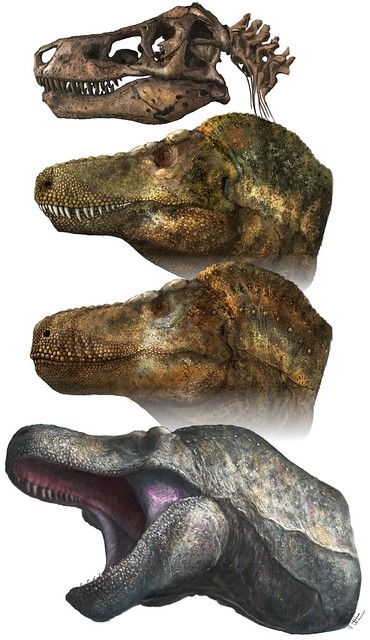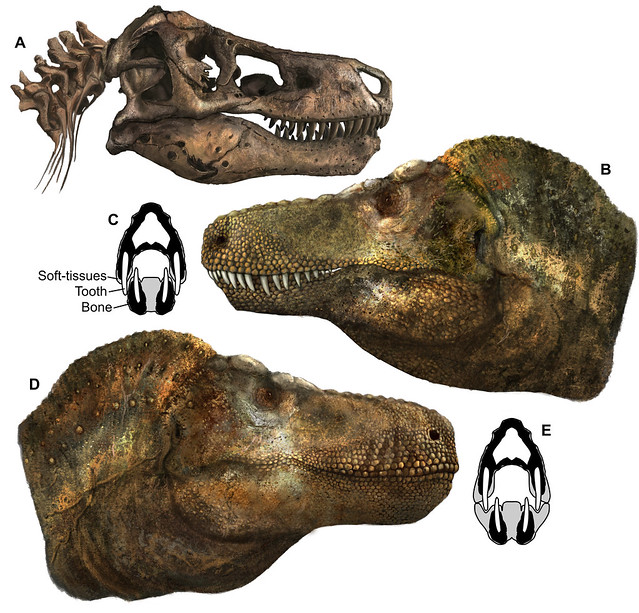Auburn professor’s research indicates Tyrannosaurus rex, Velociraptor dinosaurs had lips, contrary to popular belief
Article body
Auburn University’s Thomas Cullen is part of an international collaboration of researchers that has uncovered evidence indicating, contrary to popular belief, theropod dinosaurs like the Tyrannosaurus rex and Velociraptor had lips that covered their teeth.
Cullen — an assistant professor in the College of Sciences and Mathematics’ Department of Geosciences — and his colleagues published their findings on Science.org that contradict the mainstream traditional view about the appearance of the iconic extinct animals. Their groundbreaking research, originally covered by Science.org, has several important implications for understanding the animals’ biology and evolution.
“We reconstructed soft tissue anatomy, compared dental measurements and studied dental health and wear records to further uncover that what you are used to seeing on the big screen is not accurate,” Cullen said. “The teeth of these theropod dinosaurs did not experience wear and tear like a crocodile, and most likely had a lip-like covering.”
The scientific findings not only may change the way people will see theropod dinosaurs, but impacts studies of their paleobiology. These animals possessing lips means that their teeth wore down and functioned differently, discoveries that could impact future biomechanical reconstructions. The presence of additional soft tissues also has implications for their feeding ecology and life history.
Overall, these new results create an invaluable framework that impact dinosaur paleontology and studying the structure of ecosystems. Traditionally, animations and CGI of famous T. rex and Velociraptor dinosaurs in blockbuster movies like “Jurassic Park” have featured the animals with their teeth exposed and on display at all times.
But is this popular representation scientifically and historically correct?
Not according to Cullen and the team of researchers. They compared multiple aspects of the paleobiology of theropod dinosaurs, including:
- Tooth wear — The amount of wear on the actual enamel and dentine of their teeth showed less wear than those of their closest living relatives, the crocodile;
- Size and scale — The size of the skull in approximation to the jaw and teeth prove they could have had lips, and their teeth would not be too large to be covered;
- Bone anatomy — The surface features of the bone around the teeth are much more similar to lizards than crocodiles, including the possession of a line of small pits which house blood vessels and nerves for their oral skin and gums.
According to the researchers, the theropods’ lips were more similar to lizards and were not like the lips of mammals or humans.
“Dinosaur lips would be very different from our lips, in that although they would cover the teeth, they could not really be moved independently, couldn’t be curled back into a snarl, or make other sorts of movements we associate with lips in humans (or other mammals),” Cullen said. “In this way, dinosaur lips would be more similar to those of many lizards or amphibians, even if we typically associate the structure of lips with mammals like ourselves.”
The research team includes a wide range of experts, including (but not limited to) Cullen; Kirstin Brink, assistant professor, Department of Earth Sciences at the University of Manitoba; Mark P. Witton, University of Portsmouth; and Derek Larson, collections manager, Royal BC Museum. This project primarily represents a collaboration of former and current students of the two study senior authors. This group of researchers combined their expertise in anatomy, tooth histology, statistical analysis and evolutionary biology to explore this theory.
For Cullen’s part, many of the analyses were conducted while he was a post-doctoral student at the Field Museum of Natural History in Chicago, where he is now also a Scientific Affiliate. Measurements taken from the museum’s famous skeleton of “SUE” the T. rex played an important part in unraveling the mystery.
Related Media
Media interested in this story can contact Communications Director Preston Sparks at (334) 844-9999 or preston.sparks@auburn.edu.
Auburn University is a nationally ranked land grant institution recognized for its commitment to world-class scholarship, interdisciplinary research with an elite, top-tier Carnegie R1 classification, life-changing outreach with Carnegie’s Community Engagement designation and an undergraduate education experience second to none. Auburn is home to more than 30,000 students, and its faculty and research partners collaborate to develop and deliver meaningful scholarship, science and technology-based advancements that meet pressing regional, national and global needs. Auburn’s commitment to active student engagement, professional success and public/private partnership drives a growing reputation for outreach and extension that delivers broad economic, health and societal impact.








